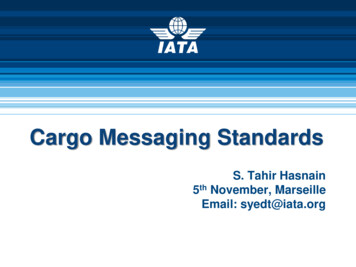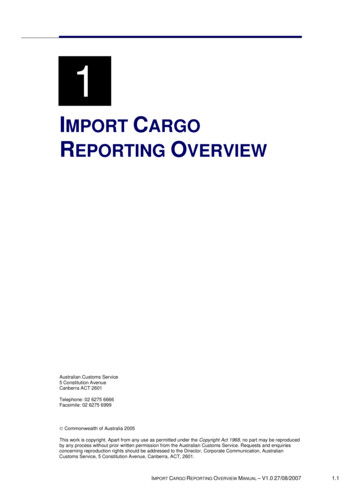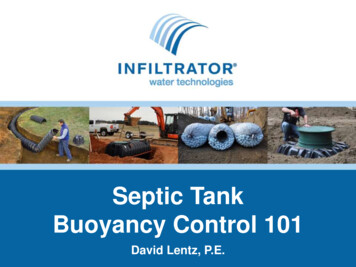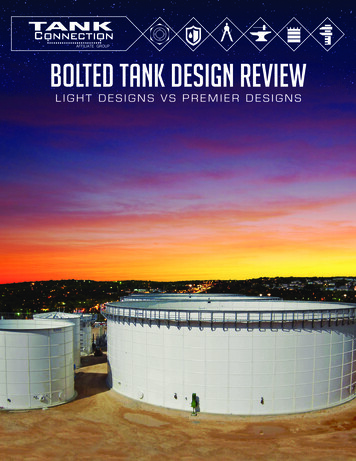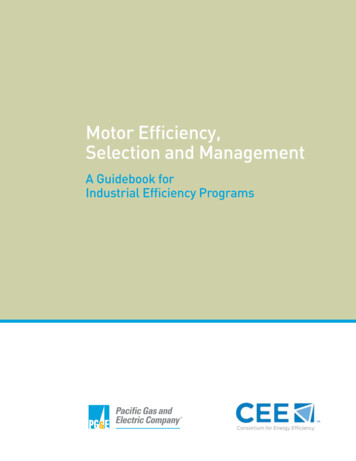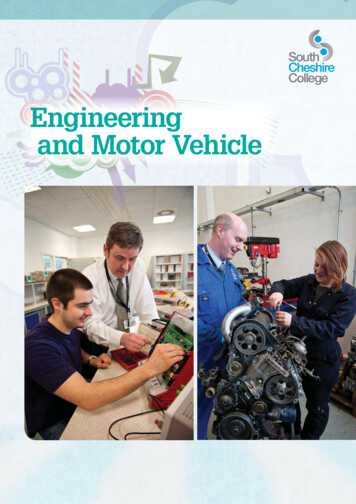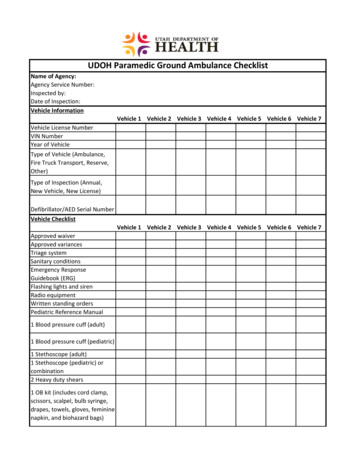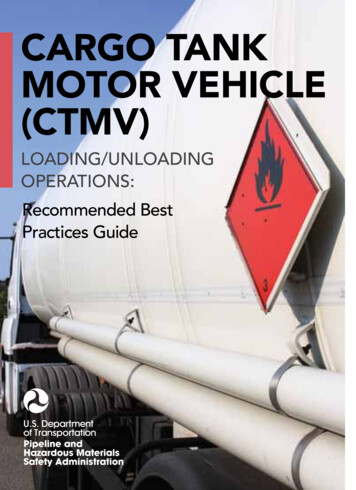
Transcription
Cargo TankMotor ed BestPractices Guide
NOTEThis recommended best practices guide preparedby DOT’s Pipeline and Hazardous Materials SafetyAdministration (PHMSA), with input from theOccupational Safety and Health Administrationand the Environmental Protection Agency, isfor informational use only and may be usedas a supplement to, not to be considered as,applicable regulations. The applicable HazardousMaterials Regulations (HMR), 49 CFR Parts 171180, are available from the Government PrintingOffice or may be accessed through our websiteat http://hazmat.dot.gov. This Guide is acompanion document to the Cargo Tank MotorVehicle (CTMV) Loading/Unloading OperationsRecommended Best Practices Pocket Guide.Need help?Call our Hazardous Materials Information Center at800-467-4922 between the hours of 9:00 AM and 5:00PM EST, Monday through Friday except Federal holidays
TABLE OF CONTENTS1. BACKGROUND2. RECOMMENDEDBEST PRACTICESa. Trainingb. Operating Procedures1-45-1257 Risk Assessment ofOperation7 Implementing OperatingProcedures8 Pre-Loading/-Unloading Loading/unloading Emergency management Post-Loading/-Unloading Design, maintenance,and testing of transferequipment Facility oversight ofcarrier personnel Recordkeeping8101111121212
TABLE OF CONTENTS3. REAL-WORLD APPLICATIONS13-18A. Training and Evaluation14B. Risk AssessmentC. Emergency ResponseD. Operating Procedures141515 Transfer EquipmentConnections15 Failure to Attend16 Compatible Materials andPackaging16 Overfills17 Unmanned Facility17APPENDIX A – CurrentDOT Requirements19-361. Definitions19 Carrier19 Hazmat employee19 Hazmat employer21 Maximum allowable workingpressure or MAWP21
TABLE OF CONTENTS Outage (ullage)22 Person222. Training Current Requirements:(§ 172.704; § 177.800;§ 177.816) Carrier responsibility Driver training3. Operating Procedures Current Requirements:(§ 173.24; § 173.24b;§ 173.30; § 173.33; § 173.315;Part 177, Subpart B) General safety Pre-Loading/-Unloading Loading Packaging andCompatibility Overfilling / OverPressurization2223242426262727292930 Attendance31 Hazmat SpecificRequirements31
TABLE OF CONTENTS Unloading33 Overfilling / OverPressurization33 Attendance3434 Hazmat SpecificRequirements Personal protectionequipmentAPPENDIX B – OtherFederal OversightOSHA RequirementsEPA RequirementsAPPENDIX C – AdditionalResources3637-39373940
BACKGROUNDBACKGROUNDPHMSA’s mission is to protect people and theenvironment from the risks of hazardous materials(hazmat) in transportation. This document is intendedto aid hazmat employers (hereinafter referred to as“employer”(s)) and others responsible for cargo tankmotor vehicle (CTMV) loading/unloading by offeringrecommended best practices to further enhance thesafety of these operations. A comprehensive summaryof the regulations applicable to CTMV loading/unloading operations is provided in Appendix A.Human error continues to be a major contributingfactor for incidents occurring during loading/unloading operations including but not limited to: Failing to attend/monitor loading/unloadingoperations;1
Leaving a valve in the wrong position either prior to,during, or after loading/unloading operations; Improperly connecting transfer equipment; Overfilling cargo tanks or receiving tanks; and Using defective/deteriorated devices and equipment.The following incidents illustrate the need for loading/unloading guidance:2BACKGROUND In June 2013, a drivermiscommunicatedcritical information tofacility personnel duringdelivery of corrosivematerial that was thenunloaded into the wrongstorage tank containingincompatible materials.Adding to the confusion,this was the driver’s firstdelivery to this location.The comingling ofincompatible materialsemitted a vaporaffecting the breathing of the driver and facilityemployee resulting in both being transported toa hospital for treatment. Also, approximately 100gallons of the mixture was released at the time ofunloading.
In July 2009, the transfer hose on a CTMV rupturedfollowing thetransfer ofanhydrousammonia from acargo tank to astorage tank. Theresulting releaseof anhydrousammonia causedone fatality,minor respiratoryproblems forseveral individuals, and the sheltering in place ofnearby residents. An investigation determined theprobable cause of the accident was the use of atransfer hose assembly not chemically compatiblewith anhydrous ammonia.1 In October 2007, a delivery driver used an improperlyrepaired transfer hose to unload LP gas from his8,000-gallon cargo tank. The hose detached from itsconnection to the vehicle’s cargo tank allowing gas to1The Federal Motor Carrier Safety Administration has issued guidance regarding thisincident, and cargo hose safety at: uefied-petroleum-gas-hoses.3BACKGROUND In November 2011, a carrier loading heating oil intoa cargo tank overfilled one of the compartmentsresulting in the release of approximately 30 gallonsof material. The cause was determined to be faultyoperation of the high-level sensor.
escape, resulting in an explosion that fatally injuredthe driver. The accident investigation revealedworkers improperly repaired a damaged LP-gastransfer hose by attaching a nozzle using fastenersnot designed to withstand pressurized gas.PHMSA believes focused training and recommendedoperating procedures can help decrease these typesof incidents. Even when human error was not themain reason for an incident or accident occurring,focused training and recommended operatingprocedures could help avoid them in the future.BACKGROUND4
A. TrainingTraining should ensure hazmat employees (hereinafterreferred to as “employee”(s)) understand and arequalified to perform duties safely and in compliancewith the Hazardous Materials Regulations (HMR).PHMSA recommends that an evaluation of employees’understanding of safe loading/unloading proceduresshould be performed on an annual basis, at aminimum. More frequent and routine practice andevaluation of operating procedures should includeobservation and feedback by a knowledgeablesupervisor on the employee’s performance of:covered functions, i.e., those regulated under theHMR; practice sessions; or drills. At a minimum,the training program should include provisions to:5RECOMMENDEDBEST PRACTICESRECOMMENDEDBEST PRACTICES
Identify employees and covered duties, i.e.,employees subject to training due to performanceof a covered function under the HMR; Observe and evaluate covered employees’performance of duties; Provide feedback regarding performance of duties; Establish a performance improvement plan foremployees failing to perform up to standard; and Initiate enhanced training if employees are no longerqualified to safely perform covered duties, or ifperformance of duties contributed to an unintentionalrelease of hazmat.Further, PHMSA recommends that employers includein the required training record of employees specificson enhanced training needed, as well as noting whenemployees safely and successfully perform loading,unloading, or transloading operations. Employers shouldonly use employees who have demonstrated that theycan correctly and safely perform these functions.RECOMMENDEDBEST PRACTICES6
B. OPERATING PROCEDURESRisk Assessment of Operation Clearly marking loading/unloading activities forwhich facility personnel or the operator of a CTMV isresponsible. Assessing current procedures used to ensure thesafety of loading/unloading operations and identifyingareas where procedures could be improved.Analysis should be tailored to the complexity of theprocess and the materials involved in the operation,including—оо The characteristics and hazards of materials tobe loaded/unloaded;оо Measures necessary to ensure safe handling ofthe material, such as temperature or pressurecontrols; andоо Conditions that could affect the safety of theloading/unloading operation, including access2 This would include any device in the loading/unloading system that is designed totransfer product between the internal valve on the cargo tank and the first permanentvalve on the supply or receiving equipment (e.g., pumps, piping, hoses, connections,etc.).7RECOMMENDEDBEST PRACTICESPHMSA recommends that persons who load, unload,or provide transfer equipment to load/unload hazmat to/from CTMVs should perform an analysis of operations;otherwise, review past analyses to evaluate hazards withloading/unloading operations,2 which should include:
control, lighting, ignition sources, and physicalobstructions. Ensuring these operations analyses are kept with theoperating procedures.Implementing Operating ProceduresWe also recommend that persons having performedan analysis should develop, maintain, and adhereto the operating procedure for the specific loading/unloading operation based on the results of theanalysis; or, update/revise current proceduresbased on such results. At a minimum, operatingprocedure(s) should include the following elements: Pre-loading/-unloading. Procedures to ensure thereliability of the cargo tank and associated transferequipment, ensure the CTMV is secured againstmovement, prepare the cargo tank and transferequipment for the loading/unloading operation, andverify the receiving container into which the materialis to be transferred, including measures to—3 Adaptors are not, by definition, part of a delivery host assembly under the HMR,but carriers may have a variety of adaptors at their disposal to connect to variouscustomer systems. Measures should be taken to ensure awareness of which adaptorsare suitable/appropriate for each distinct loading or unloading operation.8RECOMMENDEDBEST PRACTICESоо Identify the piping path, equipment lineups,and operational sequencing and proceduresfor connecting piping, hoses, or other transferconnections3;
оо Verify that the material is being transferred intothe appropriate receiving container, and that thecontainer, and its contents, are compatible withthe lading and has sufficient capacity to hold thequantity of material being transferred;оо Check components of the transfer system,including equipment such as delivery hoseassemblies, piping, and connections, toensure they are of sound quality withoutobvious defects (visually and audibly), and thatconnections are secure.оо Verify that the transfer hose and fittings aresuitable for the material to be transferred byexamining equipment markings, tags, or labels.Operators do not need to use instruments or takeextraordinary actions to verify material or receivingcontainers, or check components not readily visible.Pumps, piping, hoses, and connections supplied bya facility or the motor carrier and used to load/unloadfrom a CTMV should be compatible and maintained(if not already done so by requirement) similar to themaintenance program established for operators ofCTMVs in liquefied compressed gas service (see9RECOMMENDEDBEST PRACTICESIdeas for ensuring proper connectionsand use of transfer equipment includecolor-coding components and/or receivingcontainers or introducing specially designedconnections/couplings that only linkwith other components intended for usein the transfer of a specific material.
§ 180.416 of the HMR). The driver of the CTMV can relyon information provided by the facility operator to confirmthat transfer equipment meets requirements. Personsshould not load/unload a CTMV using components of atransfer system that could result in unsafe conditions. Loading/unloading. Persons responsible forthe loading/unloading of a CTMV should considerimplementing procedures for monitoring the transferoperation, including measures to—оо Initiate and control the lading flow;оо Monitor, where necessary, the temperature ofthe material being transferred and the pressuresof the cargo tank into which the material isbeing transferred;оо Ascertain, for materials that are heated priorto being loaded/unloaded, the heat input tobe applied and the rate at which heat will beapplied, and monitor the pressure inside thecargo tank being heated to ensure the heatingprocess does not result in over-pressurization oran uncontrolled exothermic reaction;оо Terminate lading flow; andоо Ensure the cargo tank is attended by a qualifiedperson at all times when being loaded/10RECOMMENDEDBEST PRACTICESоо Monitor filling limits and ensure the quantity ofhazmat to be transferred is the appropriate sizefor the cargo tank (containment vessel);
оо unloaded. The qualified person attending thecargo tank should have an unobstructed view ofthe cargo tank and delivery hose. Emergency management. Persons responsiblefor loading/unloading of a CTMV should considerprocedures for handling emergencies, including —оо Instrumentation to monitor for leaks/releases;оо Training for use of emergency responseequipment;оо Emergency shutdown systems and assignmentof shutdown responsibility to qualified operatorsensuring the shutdown is executed safe/timely;оо Emergency communication/spill reporting; andоо Safe startup following emergency shutdown. Post-loading/-unloading. Persons responsible forthe loading/unloading of a CTMV should considerprocedures for securing transfer equipment, transportvehicle or packaging, and containment vessel intowhich material is transferred, including—оо Evacuating transfer system and depressurizingthe containment vessel;оо Disconnecting transfer equipment safely; andоо Securing fittings, valves, and closures.11RECOMMENDEDBEST PRACTICESоо Equipment to isolate leaks/releases and takeappropriate emergency shutdown measures;
Design, maintenance, and testing of transferequipment. Transfer equipment, used to load/unloadcargo tanks, should be compatible with the lading.Transfer equipment/systems, including pumps, piping,hoses, and connections, should be maintained/testedon a routine basis at time intervals considering how often they are used, the hazmat they are used totransfer, and components’ useful life. We recommendpersons who conduct operations should develop/implement periodic maintenance schedules to preventequipment deterioration and conduct periodic operationaltests to ensure that equipment functions properly.Equipment and system repairs should be completedpromptly and prior to subsequent loading/unloadingoperations. Facility oversight of carrier personnel. Facilityoperators performing risk assessments should ensurecarriers who load/unload CTMVs at facilities—оо Are supervised by personnel trained on thefacility’s loading/unloading procedures;оо Have sufficient information to conduct transferoperations in accordance with procedures.Recordkeeping. Carrier operating procedures should remainin the transport vehicle. Facility operating procedures shouldalways be available to carriers at loading/unloading facilities.12RECOMMENDEDBEST PRACTICESоо Are provided with written instructions on how toconduct transfer operations in accordance withprocedures; or
REAL-WORLDAPPLICATIONS13REAL WORLDAPPLICATIONSThe HMR are more likely to impact carrier personnel(e.g., drivers) than facility personnel, as drivers aremore likely to perform hazmat transportation functions.Drivers are categorized as private or for-hire, thelatter representing the larger population, which is thebigger challenge for implementing best practices. It isdifficult to balance the need to tailor loading/unloadingprocedures to each facility’s unique operation with theneed for consistency for those for-hire carriers servicingnumerous facilities. Where a person has ownershipof the loading facility, transport vehicle, and unloadingfacility, a risk assessment, development of operatingprocedures, and training on those procedures is lesscomplex because it can be handled “in house.” Inreality, the loading, transportation, and unloadingof hazmat is likely to involve multiple persons;therefore, we discuss further the recommended best
practices presented above with a focus on carrierperformed loading/unloading operations to clarifywhere facility personnel should play a primary role.A. Training and EvaluationTraining and testing for-hire carrier personnel on eachfacility’s loading/unloading requirements could presentan immense task depending on the number of facilitiesserviced, variety of hazmat serviced, and size of thecompany. PHMSA suggests that employers refinetraining programs to include some form of annualtraining, the scope of which could be limited to universalfunctions. All employees performing these functionsmay not need annual retraining, thus, training regimenscould be tailored to new employees or those havingbeen involved in incidents. This annual training wouldbe for a set period of time and could be adjustedto the HMR baseline of three years for refreshertraining. Other options include limiting annual trainingto employees performing operations involving higherrisk hazmat (e.g., flammable gas) or those performingoperations at a facility with higher risks (e.g., locationsnear populated or environmentally sensitive areas).PHMSA’s recommendation that risk assessments beperformed by persons who load/unload, or providetransfer equipment to load/unload, hazmat to or from14REAL WORLDAPPLICATIONSB. Risk Assessment
a CTMV does not apply to drivers of CTMVs; rather, itapplies to employees—carrier and facility operators—involved in these operations. Additionally, carriersperforming risk assessments should focus on theintegrity of their equipment, and facilities should focuson equipment they own or have oversight of as well asthe loading/unloading operations at these facilities.C. Emergency ResponseD. Operating ProceduresCommon causes of CTMV loading/unloading incidentsare discussed below with recommended best practicesregarding roles and means to prevent similar incidents. Transfer Equipment Connections. Personsinvolved in loading/unloading operations have ashared responsibility to verify that transfer equipmentis properly connected between CTMV equipment15REAL WORLDAPPLICATIONSResponsibility for this part of the loading/unloadingoperations lies primarily with facility operators, as carriersshould not be engaged in the full scope of emergencyresponse. Carriers should, however, be involvedin emergency response dealing with preventing thefurther spread of an incident resulting in the release ofhazmat, i.e., emergency shut-down procedures. This isespecially true for operations conducted at unmannedfacilities or at retail facilities (e.g., gas stations).
and facility equipment. Verify proper connectionis made at time of connections, as well as prior tohazmat transfer, by using a connection sequencingchecklist. If multiple persons are involved, facilityrepresentatives and carrier personnel should certify(e.g., via signature) that connection integrity wasverified prior to transfer, and components of thetransfer equipment are appropriate for the hazmatbeing transferred. Compatible Materials and Packaging. The HMRprovide requirements to ensure compatibility ofhazmat with CTMVs or residue materials containedtherein. PHMSA recommends applying thesepractices to hazmat that is unloaded into receiving16REAL WORLDAPPLICATIONS Failure to Attend. The HMR places the responsibilityof attendance of CTMV loading/unloading primarilyon the carrier during the operation; however, facilitiesalso should provide trained persons to attend theoperations. Facility personnel are most familiar withthe hazmat being handled, facility structure/layout,and emergency response procedures, althoughthey need not attend in the same manner as carrierpersonnel. Facility personnel could provide on-sitesupervision via remote video with full coverage andvisual of the location. Adding a secondary layerof attendance could prevent/minimize overfills ofCTMVs or receiving containers (e.g., storage tanks).Note this level of on-site supervision is not expectedfor residential customers arranging for delivery ofhazmat (e.g., propane) for personal use.
containers/storage tanks. Facility personnel shouldplay a lead role with ensuring hazmat is beingtransferred to/from the right facility container as partof the pre-loading/-unloading procedures and, onceverified, should authorize the transfer. Additionalsteps to ensure compatibility include certifying that aCTMV has been in dedicated service for a compatiblehazmat, maintaining proof of tank wash prior toloading, and using visual aids on receiving containersat a facility to communicate the appropriate container(e.g., the chemical name, a GHS4 label, etc.). Unmanned Facility. Unmanned facilities are thosenot likely to have personnel available to assist withloading/unloading operations at the time a carrierdelivers hazmat (e.g., night deliveries). Thesefacilities are typically locked and access is given onlyto drivers that have completed some form of training4 Globally Harmonized System of Classification and Labelling of Chemicals.17REAL WORLDAPPLICATIONS Overfills. With regard to unloading (not to includetransloading) from a CTMV, both the carrier andfacility have responsibility in preventing overfills of areceiving container; however, facility operators haveprimary responsibility for ensuring that containershave enough space to handle the volume of productbeing unloaded. As part of standard procedures,carriers should include steps to verify with facilitypersonnel that receiving containers provide adequatespace, or use facility-provided checklists that verifyrequired space is available.
requirements. PHMSA recommends additionaltraining in facility operations when there are fewpersonnel and many facilities to service. Rather thana training program for each employee at each facility,carrier personnel can be trained on unique aspectsor higher risks of a facility’s operations. The extentof the training could be expanded based on thecircumstance of the carrier personnel (e.g., personnelare provided for exclusive service). Facilities couldpost a checklist that carrier personnel (i.e., drivers)can reference prior to, during, and following a loadingor unloading operation.REAL WORLDAPPLICATIONS18
APPENDICESAPPENDIX A –DOT Regulations as ofJanuary 1, 201551. DefinitionsThe following definitions of HMR terms usedthroughout Appendix A are provided forease of understanding by the reader.5 Regulations are subject to revision. Always review the GPO e-cfr for the mostcurrent regulations.19APPENDIX A:Hazmat employee means: A person who is:DOT’s CurrentRegulationsCarrier means: A person who transportspassengers or property in commerce by railcar, aircraft, motor vehicle, or vessel.
(1) Employed on a full-time, part time, or temporary basisby a hazmat employer and who in the course of suchfull time, part time or temporary employment directlyaffects hazardous materials transportation safety;(2) Self-employed (including an owner-operatorof a motor vehicle, vessel, or aircraft) transportinghazardous materials in commerce who in thecourse of such self-employment directly affectshazardous materials transportation safety;(3) A railroad signalman; or(4) A railroad maintenance-of-way employee.This term includes an individual, employed ona full time, part time, or temporary basis by ahazmat employer, or who is self-employed,who during the course of employment: Loads, unloads, or handles hazardous materials(emphasis added); Is responsible for safety of transporting hazardousmaterials; or20APPENDIX A: Prepares hazardous materials for transportation;DOT’s CurrentRegulations Designs, manufactures, fabricates, inspects,marks, maintains, reconditions, repairs, or tests apackage, container or packaging component that isrepresented, marked, certified, or sold as qualified foruse in transporting hazardous material in commerce;
Operates a vehicle used to transport hazardousmaterials.Hazmat employer means:(1) A person who employs or uses at least one hazmatemployee on a full-time, part time, or temporary basis;(2) A person who is self-employed (including anowner-operator of a motor vehicle, vessel, oraircraft) transporting materials in commerce; or(3) A department, agency, or instrumentality of the UnitedStates Government, or an authority of a State, politicalsubdivision of a State, or an Indian tribe; and who: Transports hazardous materials in commerce; Causes hazardous materials to be transported incommerce; or Designs, manufactures, fabricates, inspects,marks, maintains, reconditions, repairs or tests apackage, container, or packaging component thatis represented, marked, certified, or sold by thatperson as qualified for use in transporting hazardousmaterials in commerce.APPENDIX A:21DOT’s CurrentRegulationsMaximum allowable working pressure or MAWPmeans: The maximum pressure allowed at the topof the tank in its normal operating position. TheMAWP must be calculated as required in ASMECode (Section VIII). In use, the MAWP must be
greater than or equal to the maximum lading pressureconditions prescribed in § 173.33 of the HMR.Outage (ullage) means: The amount by whicha packaging falls short of being liquid full,usually expressed in percent by volume.Person means: An individual, corporation, company,association, firm, partnership, society, joint stockcompany; or a government, Indian Tribe, or authority ofa government or Tribe, that offers a hazardous materialfor transportation in commerce, transports a hazardousmaterial to support a commercial enterprise, or designs,manufactures, fabricates, inspects, marks, maintains,reconditions, repairs, or tests a package, container,or packaging component that is represented, marked,certified, or sold as qualified for use in transportinghazardous material in commerce. This term doesnot include the United States Postal Service or, forpurposes of 49 U.S.C. 5123 and 5124, a Department,agency, or instrumentality of the government.2. TrainingAPPENDIX A:22DOT’s CurrentRegulationsThe HMR require a training program that ensures ahazmat employee: (1) has familiarity with the generalrequirements of the HMR; (2) is able to recognizeand identify hazmat; (3) has knowledge of specificrequirements of the HMR applicable to functionsperformed by the employee; and (4) has knowledge
of emergency response information, self-protectionmeasures and accident prevention methods andprocedures. Also, there are additional trainingrequirements specific to motor vehicle transportationof hazmat. Employees must be trained prior toperforming a hazmat function and must be retrainedevery three (3) years. Regulated persons may exceedthese minimum training standards. This sectiondescribes the current training standards requiredunder the HMR and recommended best practicesPHMSA encourages regulated persons to consider6when developing training materials and programs.Current Requirements:(§ 172.704; § 177.800; § 177.816)6 PHMSA supports training and development through the Outreach and TrainingDivision. Information is available at: http://www.phmsa.dot.gov/hazmat/outreachtraining. Appendix C also lists useful training documents.23APPENDIX A:A new hazmat employee, or a hazmat employeewho changes job functions, must be trained priorDOT’s CurrentRegulationsIt is the responsibility of the hazmat employer toensure that each hazmat employee is trained inaccordance with the requirements of the HMR. Ahazmat employee who performs any function subjectto the requirements of the HMR cannot perform thatfunction unless instructed in those function-specificrequirements of HMR. Training may be provided by thehazmat employer or other public or private sources.
to performance of any regulated functions. A newhazmat employee may perform a HMR regulatedfunction prior to the completion of training provided: The employee performs those functions underthe direct supervision of a properly trained andknowledgeable hazmat employee; and The training is completed within 90 days afteremployment or a change in job function.Hazmat employee training must coverthe following elements: General awareness and familiarization of the HMR; Function-specific; Safety; and Security awareness (See § 172.704 for details.)Carrier responsibility:A carrier may not transport a hazmat by motorvehicle unless all employees involved in thattransportation are trained as required by the HMR.APPENDIX A:24DOT’s CurrentRegulationsDriver training:No carrier may transport, or cause to be transported, ahazmat unless each hazmat employee who will operatea motor vehicle has been trained in the applicablerequirements of the Federal Motor Carrier SafetyRegulations (49 CFR Parts 390-397) and the procedures
necessary for the safe operation of that motor vehicle7.Driver training must include the following subjects: Pre-trip safety inspection; Use of vehicle controls and equipment, includingoperation of emergency equipment; Operation of the vehicle including procedures formaneuvering tunnels, bridges, and railroad crossings; Requirements pertaining to attendance of vehicles,parking, smoking, routing, and incident reporting; and Loading/unloading of materials.There are specialized training requirements associatedwith cargo tanks. Each driver of a CTMV musthave the appropriate State-issued commercialdriver’s license (CDL) required by 49 CFR Part 383.Specialized training must include the following: Operation of emergency control features of the cargotank;7FMCSA provides resources for drivers. Information is available at PPENDIX A: Loading/unloading procedures;DOT’s CurrentRegulations Special vehicle handling characteristics, including:high center of gravity, fluid-load subject to surge,effects of fluid-load surge on braking, characteristicdifferences in stability among baffled, unbaffled, andmulti-compartmented tanks; and effects of partialloads on vehicle stability;
The p
this was the driver's first delivery to this location. The comingling of incompatible materials emitted a vapor affecting the breathing of the driver and facility employee resulting in both being transported to a hospital for treatment. Also, approximately 100 gallons of the mixture was released at the time of unloading. 2


